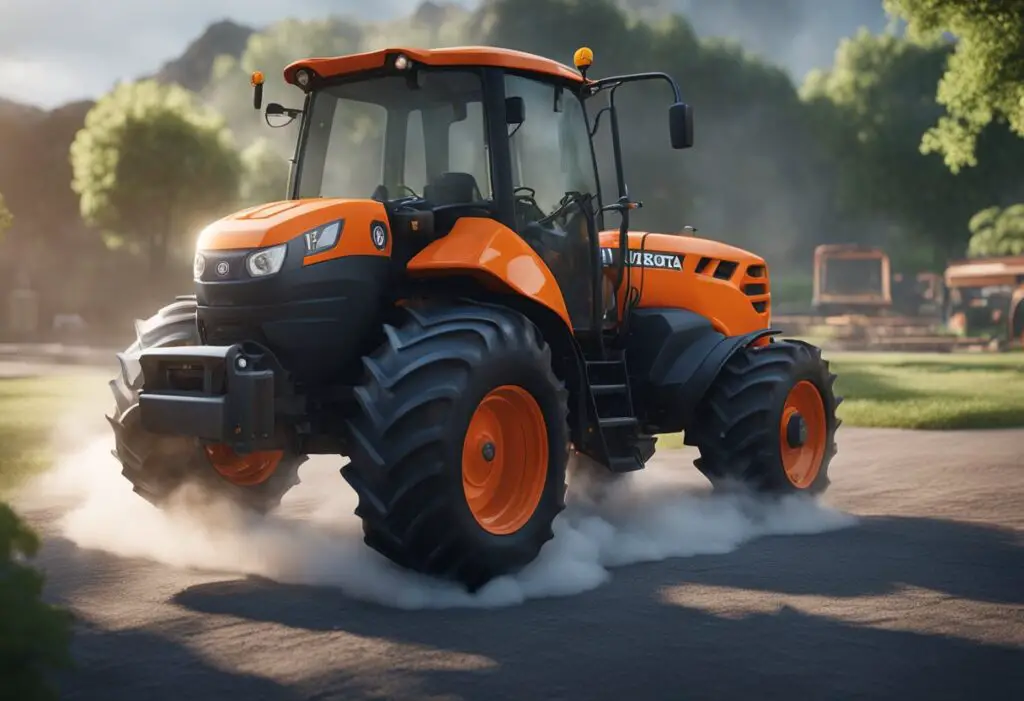The Kubota LX3310 stands out in the market as a compact tractor suited for a variety of tasks on the farm or in a landscaping setting. Its blend of power and versatility makes it an appealing choice for gardeners and property owners who require a machine that can handle an array of outdoor chores. Despite its popularity, like any mechanical equipment, the LX3310 is not without its potential issues. From starting problems to engine overheating, recognizing common challenges and knowing how to tackle them can ensure your tractor runs efficiently.

Maintaining your Kubota LX3310 is key to its longevity and performance. Regular checks and timely troubleshooting can help you avoid frequent operational setbacks, letting you make the most of its capabilities. Whether it’s integrating the right attachments for specific jobs or optimizing the tractor’s settings for peak efficiency, proactive care is a cornerstone of owning and operating this compact tractor. By staying informed on the LX3310’s quirks and fixes, you can enjoy a smooth and productive experience in whatever task you undertake.
Related read: Kubota Tractor Problems: Tips, Tricks, Fixes and More
Key Takeaways
- Understanding Kubota LX3310 issues ensures efficient operation.
- Routine maintenance is crucial for reliable LX3310 performance.
- Proper attachment use enhances LX3310 utility and efficiency.
Common Kubota LX3310 Problems and Troubleshooting
The Kubota LX3310 is a reliable workhorse, but like any complex machinery, it can encounter problems. Here, you’ll find troubleshooting advice for common issues to get your tractor back in top shape.
Starting Issues
If your Kubota LX3310 is having trouble starting, first ensure the battery is fully charged and the connections are clean and tight. If the engine cranks slowly or not at all, the battery or starter motor may need replacement.
Engine Overheating
Overheating can be caused by a low coolant level, a clogged radiator, or a failing water pump. Check coolant levels and clear any debris from the radiator fins. If issues persist, consider having your water pump and thermostat inspected.
Power Loss and Efficiency Concerns
Power loss in your LX3310 could be due to clogged fuel filters or air intake systems. Make sure to replace your filters regularly and inspect the air intake for blockages. Consistent maintenance can prevent efficiency issues.
Hydraulic System Challenges
In case your tractor’s hydraulic system fails to respond adequately, verify the hydraulic fluid levels and look for any leaks. Contaminated fluid can also affect system performance, thus requiring a fluid change.
Transmission Issues
Difficulty in shifting gears on your LX3310 can indicate a transmission problem. Low transmission fluid may cause this, so ensure the fluid is at the recommended level. If the issue continues, the transmission may need professional servicing.
Electrical Problems
Fuses can blow and wires can come loose, leading to electrical malfunctions on your Kubota LX3310. Regularly inspect wires for damage and replace blown fuses. Corrosion on battery terminals can also lead to issues and should be cleaned.
Noise and Vibration
Excessive vibration or noise might signal a problem with engine mountings or misaligned pulleys. Check for worn out mounts and belts that may need adjustment or replacement to mitigate these symptoms.
Steering Complications
Steering issues generally point to problems with the power steering system. Check for adequate fluid levels and ensure that there are no leaks or blockages in the steering cylinder or lines.
Maintenance Guidelines for LX3310

Maintaining your Kubota LX3310 involves a series of routine checks and replacements at specific intervals to keep your tractor running smoothly.
Routine Checkups and Service
Regularly examining your tractor is crucial. Inspect the air filter and coolant level every 50 hours. Check for leaks, damage, or wear on all parts. Ensure that the fuel filter is clean to prevent starting issues or engine interruption.
Handling Fluids and Filters
You should monitor engine oil, hydraulic fluid, and transmission fluid levels frequently and top them up if necessary. Replace the filters according to the intervals recommended by Kubota to ensure optimal performance and longevity of your tractor’s engine.
- Engine Oil: Check before every use, replace every 200 hours.
- Hydraulic Fluid: Check daily, change every 400 hours.
- Transmission Fluid: Inspect level regularly, change as per the maintenance schedule.
Battery and Electrical Care
Your tractor’s battery should have a corrosion-free connection. Clean the terminals and ensure tight connections. If the tractor experiences starting issues, inspect and replace the battery if needed.
Recommended Maintenance Schedule
Following Kubota’s maintenance schedule is instrumental. Replace filters and fluids at the right times to prevent breakdowns and costly repairs.
- 50 Hours: Initial checkup and change of fluids if required.
- 100 Hours: Inspect/service air filter, check all fluid levels.
- 200 Hours: Replace engine oil and filter, service fuel filter.
- 400 Hours: Change hydraulic fluid, transmission fluid, and their respective filters.
Always refer to your LX3310 user manual for the most accurate maintenance information specific to your tractor model.
Optimizing Performance and Efficiency

To maximize the value from your Kubota LX3310, focusing on key aspects such as enhancing tractor productivity and fuel efficiency, as well as improving operator comfort can significantly improve its performance and efficiency.
Enhancing Tractor Productivity
Your Kubota LX3310’s productivity can be enhanced by regular maintenance and using the optimal settings for specific tasks. Here’s how:
- Regular Maintenance: Keep up with the cleaning of air filters and check hydraulic systems to prevent power loss.
- Correct Implement Use: Match the tractor’s PTO horsepower with the right implements to avoid excessive wear and ensure efficient operation.
Fuel System Optimization
Proper maintenance and use of your tractor’s fuel system can reduce consumption and save costs:
- Fuel Quality: Always use high-quality diesel to prevent clogging and maintain engine health.
- Engine Tuning: Periodically check the engine tuning to ensure it is running at peak efficiency, thereby ensuring fuel efficiency.
Improving Operator Comfort
Your comfort is crucial for efficiency, as a comfortable operator is a productive one. To improve your comfort:
- Ergonomic Seating: Adjust your seat for the best posture and support.
- Control Layout: Familiarize yourself with the control layout for ease of use, which helps reduce fatigue during long operations.
By focusing on these specific areas, you can ensure that your tractor operates at its best, both in terms of performance and efficiency.
Attachment and Implement Integration

When integrating attachments and implements with your Kubota LX3310, it’s crucial to match the tractor’s capabilities with the appropriate equipment to ensure optimal performance and to avoid overload.
Utilizing Backhoes and Loaders
Your Kubota LX3310 can handle a variety of tasks when fitted with the right backhoe or loader. For backhoes, ensure that the model is compatible with the tractor’s hydraulic system and does not exceed its lifting capacity. Loaders should be similarly matched, and you can refer to the tractor’s manual for specific weight limits and attachment instructions to maintain balance and safety.
Mowers and Other Landscaping Tools
For landscaping projects, mowers and other tools are indispensable. To attach a mower, confirm that its size is suitable for the tractor’s PTO (power take-off) specifications. The LX3310’s increased horsepower allows you to run landscaping tools efficiently, provided that they are scaled appropriately for the tractor’s size and power to avoid undue strain on the engine.
PTO Power and Implement Compatibility
The Kubota LX3310 is equipped with a high PTO power, which allows it to work with a broad range of implements. To effectively use this power:
- Verify implement compatibility with your tractor model.
- Match the PTO HP (Horse Power) with implement requirements.
By adhering to these guidelines, you can expand your tractor’s utility and avoid common issues such as power loss or excessive wear on your equipment. Remember to always refer to the Operator’s Manual for maximum weights and sizes to ensure that your tractor functions within its intended capabilities.
Solving Specific Kubota LX3310 Issues
In owning a Kubota LX3310 tractor, you’re equipped with a powerful tool that simplifies farming tasks. Yet, sometimes issues arise, and here’s how you can address some specific problems to keep your LX3310 running smoothly.
Resolving Transmission and Steering Problems
The versatile transmission of your LX3310 is key to efficient operation, but transmission issues could hamper your tractor’s performance. When shifting gears becomes a challenge, it may be due to low tire pressure or mechanical faults within the transmission system. Ensure tire pressure is at the recommended level and consult the workshop manual (WSM) for guidance on transmission service.
For steering problems, check the steering oil level and ensure it’s correct. A low steering fluid level or air lock in the system may cause difficulty in steering. To address this, top up if necessary and perform air bleeding as per the WSM instructions. If problems persist, the steering pump or power steering control valve might require repair or replacement.
Addressing Hydraulic and Electrical Concerns
Hydraulic and electrical systems are crucial for the smooth operation of your tractor. A drop in hydraulic power often stems from low fluid levels or air lock issues. Regularly check and maintain hydraulic fluid levels. For electrical issues, start by inspecting blown fuses and ensure that the switches and connections are secure and corrosion-free.
If you’re facing slow startup, the starter motor or starter cranks slow could be indicative of a problem. Charge or replace your tractor’s battery as necessary and ensure the starter motor is functioning properly. Also, examine glow plugs for consistency in operation, especially in colder weather.
Dealing with Engine and Fuel Challenges
A robust diesel engine dictates the reliable operation of your LX3310. Engine challenges such as stalling, loss of horsepower, or overheating often boil down to maintenance issues. To preserve the engine’s horsepower, routinely check and replace the fan belt and cooling fan if signs of wear are present. Also, maintaining a proper fuel level and using clean fuel can minimize issues related to fuel injectors or clogged fuel filters.
For internal engine problems, such as issues with the connecting rod, professional service may be required. Watch for recalls that may affect your model, as these can include critical repairs related to the engine system.
Minimizing Noise and Vibration
The LX3310 may experience excess noise and vibration due to several factors, including loose engine mounts or other structural issues. Regularly inspect these mounts and tighten or replace them if necessary. Additionally, ensure that your tractor’s emissions systems are functioning to prevent undue stress on the engine that could cause vibrations.
For persistent issues that are not solved through the steps above, consult the error codes displayed by your tractor’s system to guide you towards a more specific troubleshooting avenue. Remember that timely attention to minor problems can often prevent larger issues down the line, ensuring lasting performance and less fatigue during long hours of operation.
Frequently Asked Questions

In this section, you’ll find concise answers to some of the most common queries about the Kubota LX3310.
What are some common issues faced by Kubota LX3310 owners?
You may encounter power loss, transmission problems, excessive vibration, starting difficulties, overheating, steering challenges, and occasional electrical issues with your Kubota LX3310.
How reliable is the Kubota LX3310 when it comes to engine performance?
The Kubota LX3310 is generally known for its robust engine performance, but like any machinery, it can experience performance issues, particularly after lengthy periods of use or lack of routine maintenance.
Are there any known recalls impacting the Kubota LX3310 model?
To date, there have been no widespread recalls affecting the Kubota LX3310 model. However, staying updated through official Kubota channels may provide the latest information.
What should I look out for when buying a used Kubota LX3310?
When buying a used LX3310, pay close attention to signs of the common problems mentioned, such as transmission wear or issues with steering, and verify the tractor’s maintenance history.
What maintenance challenges might I encounter with the Kubota LX3310?
Routine maintenance challenges can include addressing the wear of the tie rods or keeping up with the hydraulic systems, especially if the tractor is used extensively or in challenging conditions.
How does the Kubota LX3310’s lifespan compare with other diesel tractors?
With proper care and maintenance, the Kubota LX3310’s lifespan is comparable to other diesel tractors in its class, frequently delivering many years of reliable service.
Last updated on September 6, 2025
